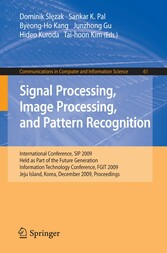Suchen und Finden
Service
Signal Processing, Image Processing and Pattern Recognition - International Conference, SIP 2009, Held as Part of the Future Generation Information Technology Conference, FGIT 2009, Jeju Island, Korea, December 10-12, 2009. Proceedings (Communication
Dominik Slezak, Sankar K. Pal, Byeong-Ho Kang, Junzhong Gu, Hideo Kuroda, Tai-hoon Kim (Eds.)
Verlag Springer-Verlag, 2009
ISBN 9783642105463 , 341 Seiten
Format PDF, OL
Kopierschutz Wasserzeichen
"A Robust Algorithm for Fruit-Sorting under Variable Illumination thresholding. (p. 153-154)
Abstract. Computer vision techniques are essential for defect segmentation in any automatized fruit-sorting system. Conventional sorting methods employ algorithms that are specific to standard illumination conditions and may produce undesirable results if ideal conditions are not maintained. This paper outlines a scheme that employs adaptive filters for pre-processing to negate the effect of varying illumination followed by defect segmentation using a localized adaptive threshold in an apple sorting experimental system based on a reference image. This technique has been compared with other methods and the results indicate an improved sorting performance. This can also be applied to other fruits with curved contours.
Keywords: Computer Vision, On-line fruit sorting, Surface defect, Adaptive thresholding.
1 Introduction
Fruit inspection and grading is an indispensable horticultural procedure. Uniformity in size, shape and colour are few of the many parameters that are vital in determining consumer acceptance. While the task at hand is to develop a machine vision system that identifies defective fruits based on odd shapes and surface defects, and to categorize them depending on consumer acceptability, the objective has to be accomplished with certain constraints [1].
Such a system has to be operable at high speeds suitable for real-time processing yielding a high throughput, must inspect the entire fruit surface, must be adaptable to varying fruit size, shape etc., and be applicable under various physical conditions like brightness, luminance etc. Over the past decade, various techniques have been proposed for defect segmentation and grading. Reference [2] uses flooding algorithm to identify and characterize different types of defects based on perimeter, area etc.
The snake algorithm discussed in [3] can be used to localize the defect and reduce false positives. Reference [4] employs a raw approach based on colour frequency distribution to associate pixels to a specific class while [5] accomplishes the same using ‘Linear discriminant analysis’ Hyper-spectral and multispectral imaging systems have also been proposed for sorting various food commodities as discussed in [6]-[7]. An inherent limitation in most of the existing techniques is their sensitivity to changing illumination conditions.
Any flash of external stimulus can result in bright patches in the captured image which could result in misclassification. Practical considerations dictate that any technique should be immune to occasional changes in external conditions and deliver acceptable performance. This paper incorporates the use of adaptive filters based on the conventional LMS algorithm as a pre-processing step prior to segmenting defects using an adaptive threshold. This paper has been organized as follows. Section 2 explains the components of the practical set-up used to capture images of the fruit to be sorted. Section 3 discusses the proposed methodology for pre-processing and defect segmentation. Results of the experiment have been tabulated and discussed towards the end."



